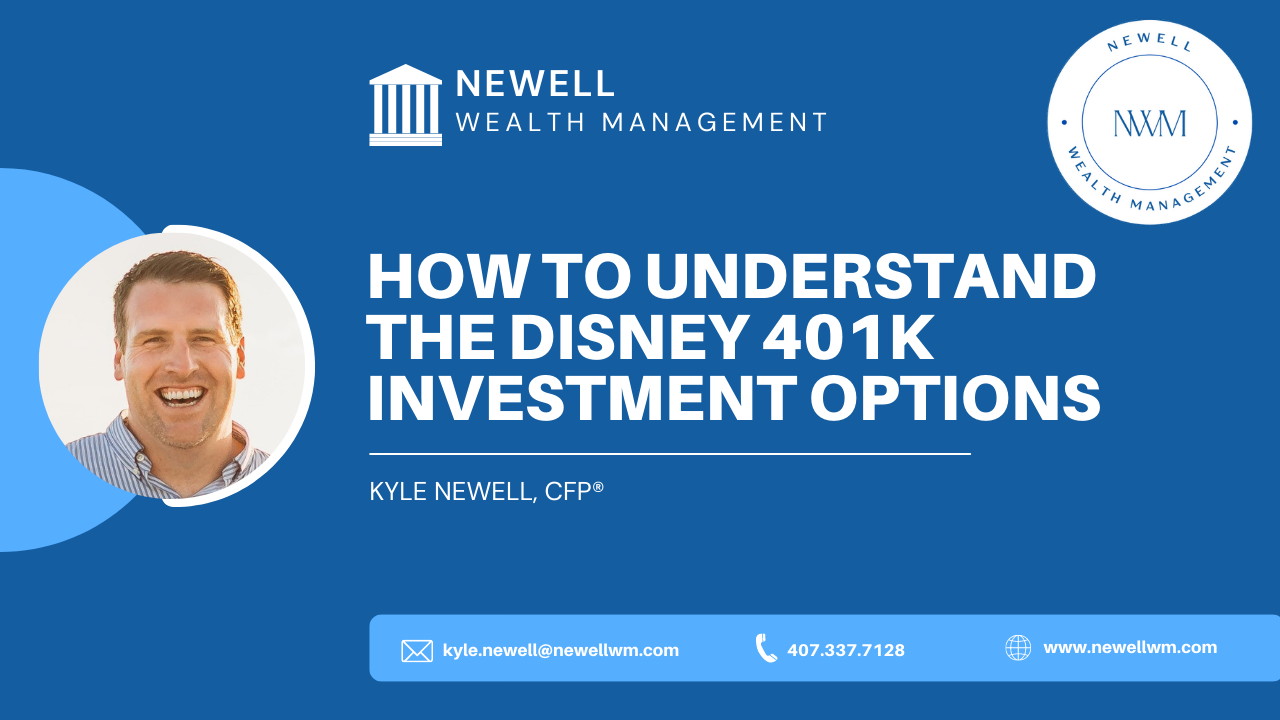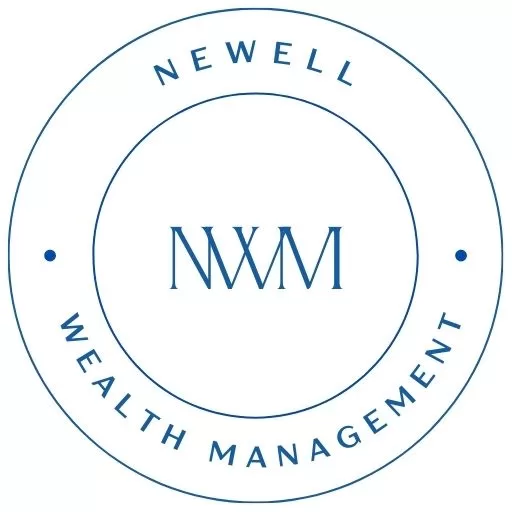How to Understand the Disney 401k Investment Options

If you are a Disney cast member, a new cast member, or a Disney leader, you may wonder what your Disney 401k investment options are. More importantly, you’re thinking about the following:
- How you should go about investing within the 401k?
- What are the pros and cons of different strategies?
- How do you put all the different strategies together?
Many of my clients are Disney cast members, past and present. I’m also a former cast member. I work with the Disney 401k program frequently and help cast members understand their options and how to make investment decisions within the Disney 401k plan.
I published an article earlier that discusses the Disney 401k benefit highlights. Today’s article will focus on your Disney 401k investment options.
Let’s start with the basics.

Disney 401k Types
There are different types of 401k plans depending on whether you are a salaried or hourly cast member.
Disney Savings Investment Plan (SIP)
The Disney SIP, which stands for Disney Savings Investment Plan, is what’s known as the Disney 401k. This is what most people think of as their 401k. You contribute, and the company puts a matching contribution.
Disney Retirement Savings Plan (DRSP)
A new salaried cast member that started after 2012 cannot access the pension in its original form. Therefore, the company offers the Disney Retirement Savings Plan or DRSP for salaried cast members. The Disney Retirement Savings Plan is basically an alternative to the pension plan of old. For example, instead of guaranteeing you a monthly payment when you turn 65, they give you a guaranteed contribution to your plan.
You do not contribute to the Disney Retirement Savings Plan (DRSP), but the company is putting a contribution on your behalf based on your
- Age
- Years of service
- Compensation
Disney 401k Investment Options
Investment options break down into three main categories.
Managed Account
The managed account is the ability to have Fidelity, who holds the 401k, make the investment decisions for you. They typically do a rebalancing every quarter. Rebalancing means they will shift the funds around.
You’ll start this strategy by filling out a profile and risk tolerance questionnaire. Once completed, Fidelity will categorize you as a conservative, moderate, or aggressive approach. Based on the category, they will select the funds for you and make changes on an ongoing basis.
The downside of that is that there’s no human involvement. You are left to decide whether it’s the best strategy for you. Having a risk tolerance questionnaire is great; however, how people answer the questions doesn’t always reflect things like
- How they should be doing things
- How they want to do things
For example, just because you want to be conservative doesn’t mean you shouldn’t be more aggressive than you would like to have your money work for you. Basing your investment strategy on a questionnaire only can skew your investments one way or the other.
Although they do choose your investments for you on an ongoing basis, it’s important to note that this is not a free service. The managed account strategy does have a cost associated with it.
Target Date Funds
This is similar to the managed program, except rather than choosing several different funds within the 401k, the target date fund is a fund of funds itself. Sound confusing? Let me explain.
The target date means the year that you plan to retire. It may be 2035, 2040, or any specific target. Whatever the number of the fund is, that’s the year you plan to retire.
BlackRock manages this fund rather than Fidelity. They make assumptions about your asset positioning based on your target date. If you plan to retire in 2035, your assets should generally be positioned like “x.” There is typically a mixture of stocks and bonds in various categories.
This strategy is acceptable. It’s definitely better than doing nothing. Again, it’s not personalized to you as an individual. It may or not work best for you. As with managed accounts, it’s up to you to evaluate whether it’s a good investment strategy.
When deciding, most people tend to look at what an investment has historically done. If it made money, they would invest. It’s not that simple. As a financial planner, I know past performance does not indicate future results. What worked in the past might not work moving forward.
Choosing Your Own Investments
The third option is to choose the investments yourself. The bulk of the rest of this article is about
- What Disney 401k investment options are
- How to think about the strategies
- The pros and cons of each
- How to blend them together
Rarely should one have all of their money in just one investment. We never know what the future may hold. Choosing one sole investment may work out, but the risk is high if it doesn’t.
Types of Funds
Disney 401k investment options are typically divided into passive index funds and actively managed funds. From a broad perspective, these are the two categories presented to you when making your selections.
Passive Index Funds
Passive index funds are funds that are trying to match their benchmark. The benchmark is the category of investment they are judging themselves against to see if they are aligned or way off the benchmark.
The idea is that they aren’t going to try and outsmart anyone. Whatever the market type is, or whatever the market does, is what they participate in. Generally, there are U.S. stocks and international stocks, and many other categories.
S&P 500
A passive fund might be choosing to match large U.S. company stocks, known as the S&P 500 Index. There is also a Dow Jones index which has a smaller sample size. A passive fund then buys the companies in that index.
The indexes are formed by a committee that chooses which companies to include. The S&P 500, for example, holds 500 companies selected by the committee for that index. Businesses are most commonly chosen based on how big they are, how much value they have, and some other qualifications. All of which is publicly available information.
Passive funds invest all of the money in the fund into those 500 companies. They do this for the S&P 500 as well as International markets.
International Markets
International markets are also divided into categories: Emerging and Developed.
When considering international markets, one point is how much you want to be invested in international markets and whether you feel they will perform better or worse than the U.S. market.
Emerging markets include Brazil, Russia, India, China, etc. They are often viewed as possible options for good growth prospects. At the same time, they can be very volatile. The risk vs. reward may not be beneficial, depending on your situation.
Developed markets include Europe, Canada, Japan, Australia, etc. Each market will have its own index created to match and represent the respective countries well.
Passive Fund Pros and Cons:
The key identifier of a passive fund is that it takes publicly available information and invests in it without a thought process behind which companies to invest in.
The benefit of a passive or index fund is that the cost is substantially lower than an actively managed fund. Remember, they’re not really doing anything other than just buying the stock that somebody else has told them the index is comprised of.
There’s been a lot of research that cost is one of the main factors on the overall performance of investment over the long term. It’s challenging for actively managed funds to outperform their costs, especially in efficient markets like large U.S. companies.
Passive funds are generally beneficial because they cost less and match the index. The downside is that you won’t get outperformance if you’re trying to earn more than what the index is doing.
Smaller markets, international markets, and smaller companies may be less efficient areas of the market where you might want to consider actively managed funds. Fixed incomes, or bonds, are another area where actively managed funds sometimes have a better opportunity to outperform.
Actively Managed Funds
These are funds where there is a portfolio manager or portfolio management team. They often also have a research team. They are spending money and resources to evaluate specific investments.
If it’s an actively managed stock, they are
- Listening to quarterly calls with their leadership team
- Looking at competitors
- Doing research and due diligence
There is a higher cost with actively managed fund investment strategies because of the human element. People are working with the sole purpose of beating their benchmarks. They also work to beat the S&P 500 year in and year out.
Actively managed funds employ all different sorts of strategies. There are very few actively managed funds within the Disney 401k investment options and many 401k plans. One fund is trying to actively beat its mid-cap index for medium-sized companies. To give you an idea of how companies are valued:
- Small companies: $500 Million and under
- Medium-sized companies: $500 Millon to $1 Billion
- Large companies: $1 Billion+
Everybody looks at them differently, so it’s essential to know what index the fund is trying to match and how it fits into your overall portfolio. Currently, the actively managed funds within the 401k are:
- Mid-sized company-managed fund
- Internationally managed fund
- Bond managed fund
Stocks and Bonds
Stock is ownership in a company. Typically it’s equated to ownership of future cash values or cash flows. If you own Disney stock, you own part of the Disney company. The value of stocks may go up and down. You may enjoy the benefit of dividends. As a company creates value over time, hopefully, its stock value goes up too. As with all investments, that’s never guaranteed.
A bond is a loan to a company. The loan usually has terms such as five, ten, or 20 years. The company may borrow $10,000 from you, and they’ll pay you a certain amount of interest. At the end of the term, they pay you the money back with the interest accrued.
Within a Disney 401k, you have passive funds, actively managed funds, stocks, and bonds. How do you position your portfolio with all of that information? Start by identifying your risk tolerance.
Risk Components
Let’s look at the three risk components related to your Disney 401k investment options.
Risk Tolerance
Risk tolerance is defined as how comfortable you are with taking risks. A basic Google search will return many risk tolerance questionnaires. Each will give you different situations to identify whether you are a conservative, moderate, or aggressive investor.
The idea is to determine your asset allocation. How much do you have in stock? How much do you have in bonds? Aggressive investors typically have more in stocks. Conservative investors have more in bonds.
Risk Capacity
How much risk can you afford to take? In general, the younger you are, the more risk you can afford to take because the investments that you’re making are for a very long time, 20, 30, or 40 years from now.
Someone closer to retirement may be unable to afford to take as much risk. Suppose your portfolio drops to 40% of its value, and you must live off the money for the rest of your life. In that case, it dramatically increases the probability that you will run out of money.
How Much Risk Do You Need to Take?
This question jumps into the financial planning aspect of looking at investment strategies to help you reach your financial goals, especially for retirement. You may be a conservative investor, but at 25 years old, you need to take more risk than you may be comfortable with. You need your money to work for you, or you will have to save ungodly amounts of money to retire.
Sometimes I have older investors who are close to retirement and very comfortable taking risks. These investors want to be 100% invested in stocks. This is fine if you can afford it. If you can’t, it may be time to significantly reduce risk to smooth out their retirement income as they age.
Determining what your asset allocation should look like involves thinking about and quantifying all three components.
- How much risk you are comfortable taking
- How much you can afford to take
- How much do you need to take
Specific Disney 401k Investment Options
Here is a list of each of the Disney 401k investment options.
Passive Index Funds List
Disney Stock
There is no cost associated with Disney stock, which is nice, but you own part of Disney. Individual stocks do have the ability to have magnificent gains over time. The risk is that an individual stock can go bankrupt, and you lose all of your money.
As a Disney cast member, you have Disney-specific risks if you are investing in Disney. Something that doesn’t affect the rest of the market can happen specifically to Disney and can hurt your chances of retiring.
Vanguard Institutional 500 Fund
Vanguard is a well-known company whose fund is trying to match the S&P 500. The cost is low. There will be a lot of risk-reward tradeoffs with it because stocks historically have done very well over a long period of time. You could experience something like
- 2008 where you lose approximately 50%
- 2022 where you lose approximately 20%
- 2018 where you gain almost 20%
Vanguard Institutional Total Stock Market
This one looks at the entire stock market between various companies weighted by size. Most often, you end up with primarily large U.S. companies, a smaller amount of medium-sized companies, and an even smaller segment of small companies.
Other Passive Fund Options
- The Vanguard Mid-Cap Index: Medium company index matching
- The Vanguard Small Cap Index: Small company index matching
- BlackRock EAFE (Europe, Asia, Far East) Equity Index: International developed markets, not including Canada
- BlackRock Emerging Market Index
- Global Sustainability Index: Mix of U.S. and International companies with sustainability metrics, which are often defined differently across markets and companies
- Vanguard Institutional Total Bond Index: Matches all aggregate bonds across corporate, municipal, and treasury bonds
Actively Managed Funds
Each of these seeks to outperform the performance of their chosen market. There may be costs associated as these are actively managed.
- Baron Growth Unitized Fund: Focused on trying to outperform the performance of medium-sized companies. Sometimes they do, sometimes not.
- Fidelity Diversified International Fund: Looks at international investments to decide which investments to select based on the goal of trying to outperform the international market.
- BTC Total Return: Considers bonds, not stocks, based on issuers, risks, and rates to build a high-performing bond portfolio against the general market
- Vanguard Money Market Fund: Money market funds try to hold the value of $1, but that is not guaranteed. They carry short-term, very conservative investments like government bonds that pay an interest rate and hopefully don’t fluctuate much. The downside is that you will have less earnings relative to other investments.
Planning Your Disney 401k Investments
There are steps you can take now that you have the basic overview of your Disney 401k investment options. Start by considering your risk components and researching the options. Dive deeper into each fund. Look at things like
- Performance History
- Team structure and changes
- Investment Process (and do you agree with it)
Remember that when looking at your investment decisions, it’s not only risk. There are other deciding factors.
- What are your financial goals?
- What is your financial situation?
- What does your timeframe look like?
- When do you need the money?
- Are there other factors, like age, health, etc., that may affect your strategy?
I hope this article has helped you understand the different Disney 401k (SIP) investment options and given you the basics you need to understand them. If you would like guidance from a financial planner experienced with the Disney 401k, I’m happy to help.
We can meet virtually or in person if you live in the Central Florida area. Please email me at kyle.newell@newellwm.com, call/text at 407.337.7128.
Important Information
Newell Wealth Management, LLC (“NWM”) is a registered investment advisor offering advisory services in the State of FL and in other jurisdictions where exempted. Registration does not imply a certain level of skill or training. The presence of this website on the Internet shall not be directly or indirectly interpreted as a solicitation of investment advisory services to persons of another jurisdiction unless otherwise permitted by statute. Follow-up or individualized responses to consumers in a particular state by NWM in the rendering of personalized investment advice for compensation shall not be made without our first complying with jurisdiction requirements or pursuant an applicable state exemption.
All written content on this site is for information purposes only and is not intended to provide specific advice or recommendations for any individual. Opinions expressed herein are solely those of NWM, unless otherwise specifically cited. Kyle Newell and NWM are neither an attorney nor an accountant, and no portion of this website content should be interpreted as legal, accounting or tax advice. Material presented is believed to be from reliable sources and no representations are made by our firm as to other parties’ informational accuracy or completeness. There is no assurance that the views or strategies discussed are suitable for all investors or will yield positive outcomes. Investment involves risks including possible loss of principal and unless otherwise stated, are not guaranteed. Any economic forecasts set forth may not develop as predicted and are subject to change. All information or ideas provided should be discussed in detail with an advisor, accountant or legal counsel prior to implementation.
